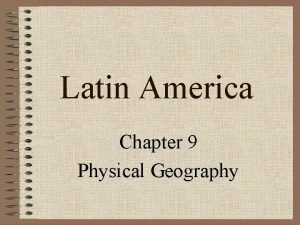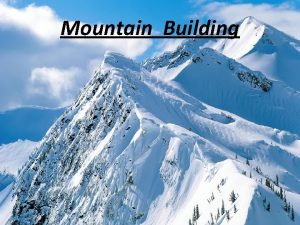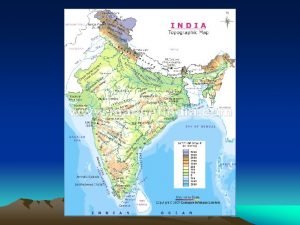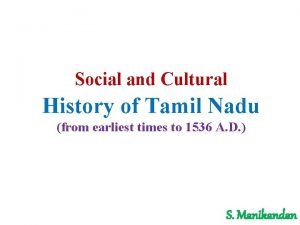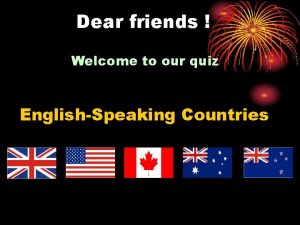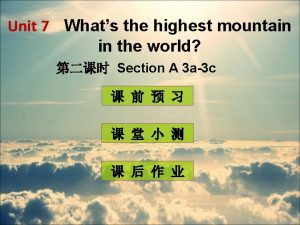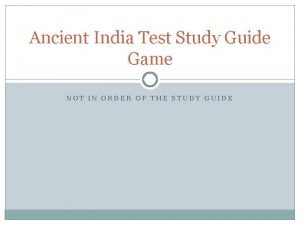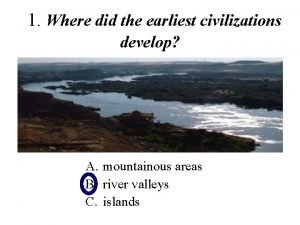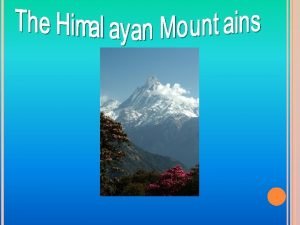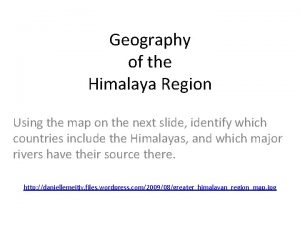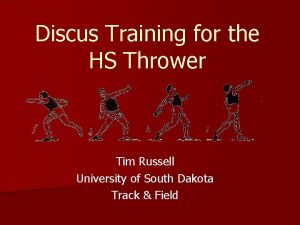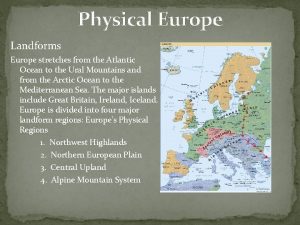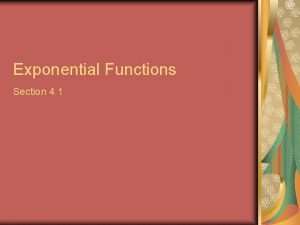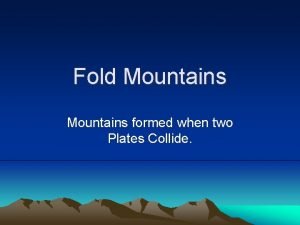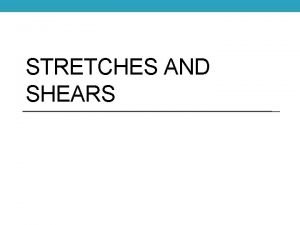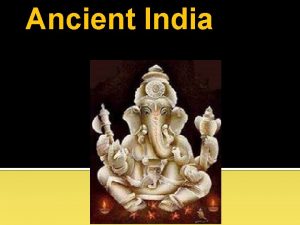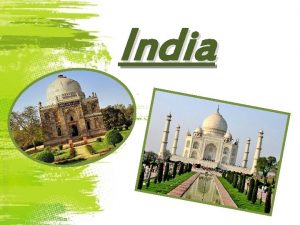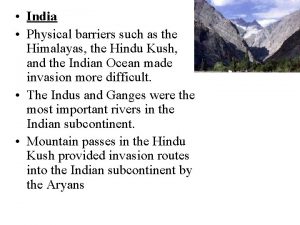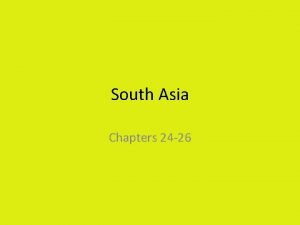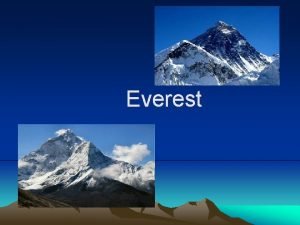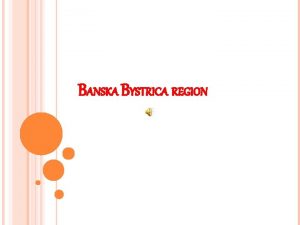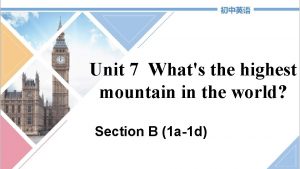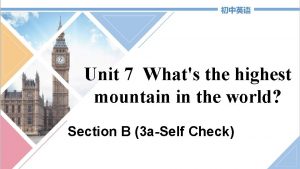India Stretches south from the Himalayas Highest mountain





















- Slides: 21

India

�Stretches south from the Himalayas ◦ Highest mountain range in the world ◦ Subcontinent in the Indian Ocean �Geography limited contact with other cultures ◦ Himalaya and Hindu Kush Mountain Ranges ◦ Bay of Bengal, Indian Ocean, Arabian Sea �Passes in the mountains ◦ Allowed for migration into the Indus River Valley �Great rivers begin in the mountains ◦ Indus River ◦ Ganges River ◦ Make farming possible down below Location & Geography

India and its Rivers

�Monsoons Strong winds that blow across the region at certain times of the year ◦ Dry air blows from NE �Oct – May ◦ Rains blow up from Indian Ocean �Middle of June �Drenches the valleys and plains Monsoons

�Rich soil ◦ Wheat and grains ◦ Lots of food led to population increase �Well planned cities flourished 25001500 BC ◦ Harappa ◦ Mohenjo-Daro ◦ The larger of the two �On banks of Indus River Life in the Indus River Valley


�Built above ground level ◦ To protect from floods �Homes and workshops on one side of the city ◦ Public buildings on the others �Highest point of the city served as the citadel ◦ Fortress ◦ Built on a high mound of earth ◦ Enclosed by a high brick wall ◦ Would have protected most important buildings �Storehouse for grain �Bath house �Clay pipe drains ran under the brick streets ◦ Carried waste out of the city �Canals outside the city to handle the flooding ◦ Redirected the water to where it was needed Mohenjo-Daro: Carefully Built


�Merchants owned shops along the streets ◦ Trade came from as far as Mesopotamia ◦ Jewelry ◦ Bright clothing �Homes opened to courtyards ◦ Children played with toys and pets ◦ Adults enjoyed games and music �No idea as to their language ◦ Writing on square seals ◦ Don’t know about their religion or government either ◦ Evidence supports they had multiple gods Life in Mohenjo-Daro

�Indus valley farmers began to abandon their land around 2000 BC ◦ Climate change? ◦ Earthquakes and floods destroyed canals? �Aryans entered valley b/w 2000/1500 BC ◦ “noble” or “highborn” ◦ Nomadic herders ◦ Drove horse-drawn chariots �Overwhelmed local people militarily ◦ Intermarried with the locals �Combined Aryan and native culture Rise of the Aryans

�Iron age in 800 BC ◦ Used axes to clear rain forest of northeast ◦ Built cities �Religion books: Vedas ◦ “knowledge” ◦ Tells us much about Aryan Life �Herders and warriors ◦ Lived in temporary villages �Three social classes ◦ Aryan Priests: Brahmans ◦ Warriors and Nobles ◦ Artisans and Merchants ◦ Later a fourth formed: Farm workers, laborers, servants Aryan Life

�Strict division of classes – Caste system �Each caste (class) had special duties �People had to stay in the caste of their parents ◦ People of the same caste had the same occupation ◦ People did the same jobs as their parents �Castes divided into hundreds of different groups over times Caste System

�The Hindu religion developed over 3500 years ◦ Absorbed beliefs of many religions ◦ Different people need different ways of approaching god �The religion has no single founder �Worships many gods and goddesses �Belief in one spiritual power: brahman ◦ Lives in everything Hinduism

�Different gods and goddesses stand for different parts of Brahman ◦ Take many different forms (avatars) �Representation of a Hindu god or goddess in human or animal form �Brahma ◦ Creator ◦ Born from a golden egg ◦ Created Earth and everything on it ◦ Not as widely worshipped Brahma

�The Preserver �Kindly god concerned with welfare of humans �Visits earth to protect mankind Vishnu

�The Destroyer �Not concerned with human matters �Very powerful �Responsible for creative and destructive forces of universe Shiva

�Wife of Shiva �Also a creator and destroyer Shakti

�Hindu religious text �Means “sitting near a teacher” �In the form of questions by pupils and responses by teachers Upanishads

�Reincarnation: Rebirth of the soul �Belief that when someone dies, the soul is reborn in the body of another living thing �Every living thing has a soul �Actions of one’s life affect his fate in the next ◦ Good behavior rewarded: reborn into a higher position ◦ Bad behavior punished: reborn into a lower caste �Maybe even return as animals ◦ Perfect life: he or she may be freed from this cycle of death and rebirth �Soul becomes one with Brahman Reincarnation

�Dharma: Moral duties of each person ◦ Depend on caste, age, and occupation ◦ Man’s duty to protect the women in his family ◦ Ruler’s duty to protect his subjects �Ahimsa: Nonviolence ◦ All living things are part of Brahman ◦ Must be treated with respect �Many Hindus do not eat meat ◦ Try to avoid harming living things A Hindu’s Duties

�Yoga means “union” ◦ Goal is to free the soul from the worries of the world �Different types of yoga ◦ Yoga of physical activity ◦ Yoga of selflessness: Giving to the poor ◦ Yoga of following religious practices �Private devotion ◦ Personal gods ◦ Private altars and offerings Yogas
 Highest mountain range in south america
Highest mountain range in south america A mountain is a large landform that stretches
A mountain is a large landform that stretches Shiwalik formation
Shiwalik formation Gulf of mannar
Gulf of mannar Highest mountain
Highest mountain Whats the highest mountain in australia
Whats the highest mountain in australia Himalayas map
Himalayas map What civilization did the himalayas separate china from
What civilization did the himalayas separate china from Himalayas formation
Himalayas formation Geographical map of himalayas
Geographical map of himalayas Stretches for discus throwers
Stretches for discus throwers European landforms
European landforms Lesson 6-4 transforming linear functions answer key
Lesson 6-4 transforming linear functions answer key Desk stretches
Desk stretches Adductor stretches for runners
Adductor stretches for runners Exponential function concept
Exponential function concept Where does the supinator originate
Where does the supinator originate Physical features of latin america map
Physical features of latin america map 2 fold mountain ranges in ireland
2 fold mountain ranges in ireland Old south vs new south streetcar named desire
Old south vs new south streetcar named desire Vẽ hình chiếu đứng bằng cạnh của vật thể
Vẽ hình chiếu đứng bằng cạnh của vật thể đại từ thay thế
đại từ thay thế
